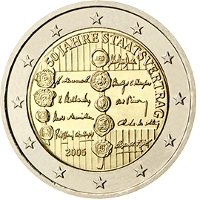 |
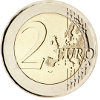 |
C o m m e m o r a t i v e
C o i n s |
||
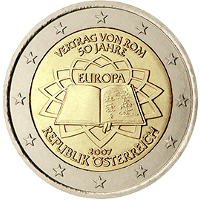 🔎
🔎 |
 |
Austria | 25 Mar. 2007 | 50th anniversary of the Signature of the Treaty of Rome |
20001 20002 20005 |
9,000,000 |  |
National characteristics : At the top are the words "VERTRAG VON ROM" (Treaty of Rome) and "50 JAHRE" (50 Years), below it is an illustration of the treaty with the words "EUROPA" (Europe), below that is the year "2007" and the country name "REPUBLIK ÖSTERREICH" (Republic of Austria). The coin was minted without a mint mark by the Austrian Mint Münze Österreich AG in Vienna. |
|||||||
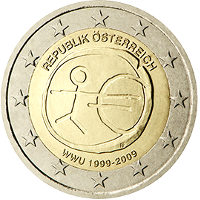 🔎
🔎 |
 |
Austria | 02 Jan. 2009 | 10th anniversary of the Economic and Monetary Union (EMU) |
20001 20002 20005 |
5,000,000 |  |
National characteristics : Above is the name of the issuing country "REPUBLIK ÖSTERREICH" (Republic of Austria), the acronym of the occasion of issue below is "WWU". The coin was minted without a mint mark by the Austrian Mint Münze Österreich AG in Vienna. |
|||||||
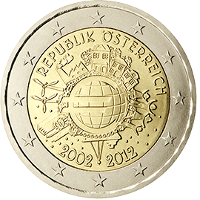 🔎
🔎 |
 |
Austria | 02 Jan. 2012 | 10th anniversary of the Euro‐Currency |
20001 20002 20005 |
11,060,000 |  |
National characteristics : At the top of the coin is the name of the issuing country "REPUBLIK ÖSTERREICH" (Republic of Austria). The coin was minted without a mint mark by the Austrian Mint Münze Österreich AG in Vienna. |
|||||||
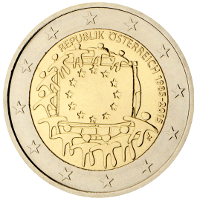 🔎
🔎 |
 |
Austria | 30 Oct. 2015 | 30th anniversary of the EU‐Flag |
20001 20002 20005 |
2,500,000 |  |
National characteristics : Above is the name of the issuing country "REPUBLIK ÖSTERREICH" (Republic of Austria), followed by the dates "1985‐2015". The coin was minted without a mint mark by the Austrian Mint Münze Österreich AG in Vienna. |
|||||||
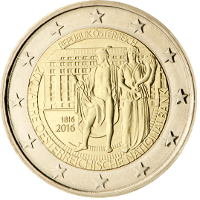 🔎
🔎 |
 |
Austria | 02 Dec. 2015 | 200th anniversary of the foundation of Austria's central bank "Oesterreichische Nationalbank" |
20001 20002 20005 |
16,060,000 |  |
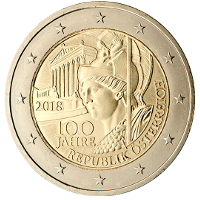 🔎
🔎 |
 |
Austria | 06 Dec. 2017 | 100th anniversary of the establishment of the Republic of Austria |
20001 20002 20005 |
12,660,000 |  |
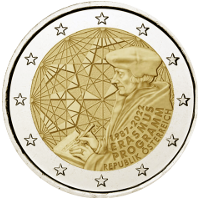 🔎
🔎 |
 |
Austria | 01 Jul. 2022 | 35th anniversary of the Erasmus Program |
20003 20005 20009 |
2,600,000 |  |
National characteristics : The quarter circle at the bottom right has four lines; below the commemorative period the occasion of issue "ERASMUS PROGRAMM" (Erasmus Programme in German) is written in two lines, below it the issuing country "REPUBLIK ÖSTERREICH" (Austrian Republic). The coin was produced without mint mark by the Austrian mint Münze Österreich AG in Vienna". |
|||||||
| References : | |||
| 20001 | Images taken with authorisation by the ECB ‐ Mail dated 20.Feb.2020 © "European Central Bank" |
20002 | Data mirrored from Wikipedia Page "2_euro_commemorative_coins" with friendly support of the guardians of that page. |
| 20003 | Not Applicable | 20004 | Coloured version of this Commemorative Coin in circulation EU‐legal‐technical specifications do not recongnise colour prints. The EU nevertheless tolerates them, as their numbers are very small and they are sold in special packs and therefor are very unlikely to be used as currency. |
| 20005 |
enlarged Images taken with authorisation by Gerd Seyffert © "Gerd Seyffert 2021" |
20006 | Not Applicable |
| 20007 | Images taken by Münzen Kreuzberg © "Münzen Kreuzberg 2021" |
20008 | enlarged Images taken by Münzen Kreuzberg © "Münzen Kreuzberg 2021" |
| 20009 | Text with kind permission by Gerd Seyffert © "Gerd Seyffert 2023" |
20010 | Not Applicable |
 |

